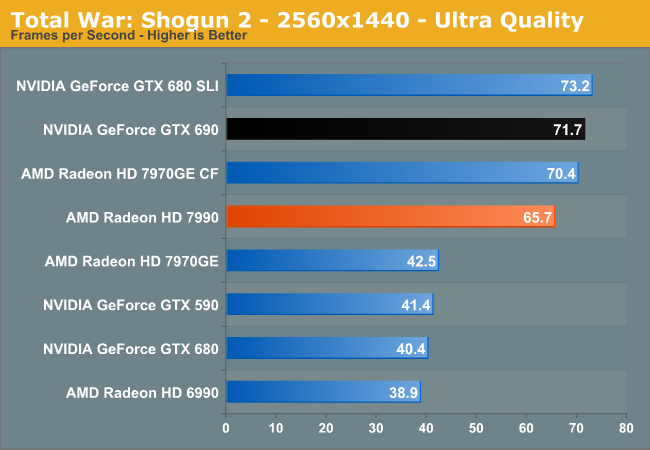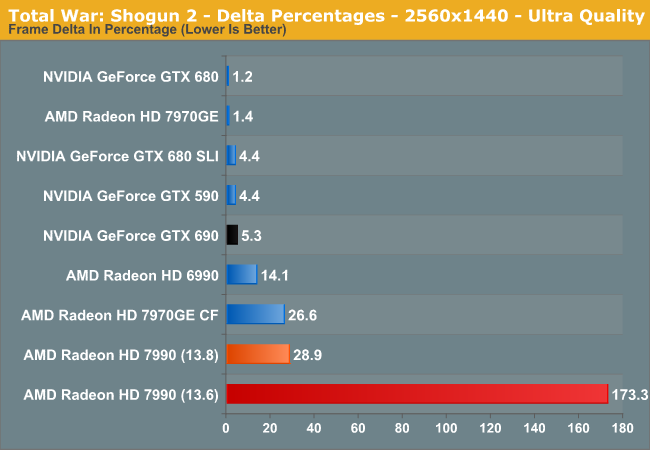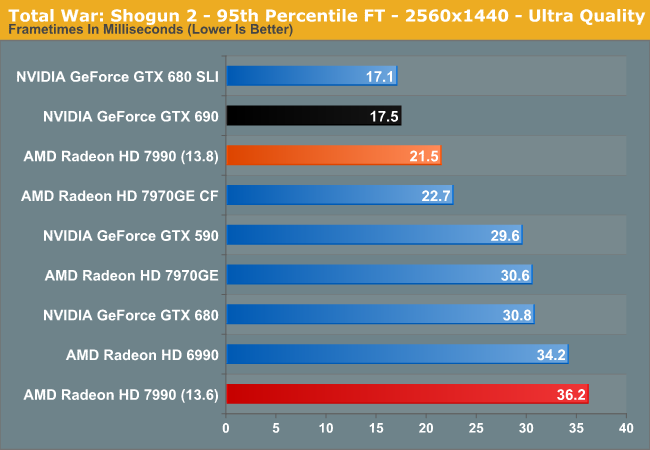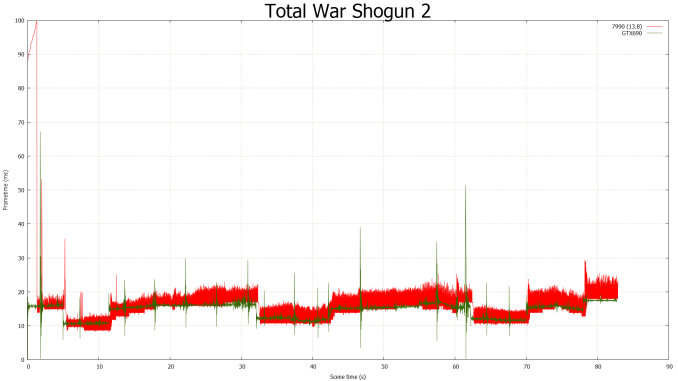AMD Frame Pacing Explored: Catalyst 13.8 Brings Consistency to Crossfire
by Ryan Smith on August 1, 2013 2:00 PM ESTTotal War: Shogun 2
Our first detailed benchmark is Shogun 2, which is a continuing favorite to our benchmark suite. Total War: Shogun 2 is the latest installment of the long-running Total War series of turn based strategy games, and alongside Civilization V is notable for just how many units it can put on a screen at once. Even 2 years after its release it’s still a very punishing game at its highest settings due to the amount of shading and memory those units require.

For the sake of completeness we’re posting our frame rate charts for each of our individual games, but in general there’s nothing here we haven’t seen before in the 7990 review, in other reviews, or in Bench. The 7990 and GTX 690 still swap places fairly regularly.

Looking at our expanded delta percentages for Shogun, we can see how the 7990 and other Crossfire solutions stack up to the GTX 690 and other SLI solutions. For all AFR configurations the results match what we saw in our summary, with NVIDIA’s solutions offering lower deltas than AMD’s even with the new drivers.
This is actually AMD’s weakest game, with both the 7970GECF and 7990 exceeding 20% variability on this game. However it’s also the only non-action game in this collection, so it’s the game least affected by higher levels of variation and consequently the game AMD can afford to do the worst at. Nevertheless the improvement over Catalyst 13.6 without frame pacing is nothing short of amazing.
Meanwhile we’ll hit upon this a few times, but as a reminder AMD’s frame pacing improvements apply to older cards too, so the 6990 has its frame pacing problems resolved like the rest of AMD’s multi-GPU cards. It actually does better than the rest, we believe due to the fact that the lower framerate and higher frame times give AMD’s drivers more time to analyze and schedule frames.
Looking at the FCAT graphs, we can see that the higher variability of the 7990’s frame times is represented well. Though NVIDIA’s frame time spikes are more extreme than AMD’s.

Finally we have our 95th percentile frame times. Despite the fact that AMD’s framerates are down slightly versus Catalyst 13.6, their 95% percentile times are way up. Simply by instituting frame pacing they’ve dropped from 36.2ms to 21.5ms per frame.











102 Comments
View All Comments
waldoh - Thursday, August 1, 2013 - link
Its unfortunate it a competing company to shine light on an issue for another to address it.waldoh - Thursday, August 1, 2013 - link
took*tackle70 - Thursday, August 1, 2013 - link
I'd say it's more like expected than unfortunate. This is why competition is a good thing and why you never want one company to blow away another - competition makes all companies serve their customer better.Big time kudos to AMD for their work on this; it's nice to see real competition available again in the $500+ market.
Rezurecta - Thursday, August 1, 2013 - link
Excellent and well said.HisDivineOrder - Thursday, August 1, 2013 - link
I think he was referring to the fact that this issue was present for many years and not only did reviewers not catch on despite common complaints (and HardOCP) discussing the issue, but the company making the card was apparently completely blindsided by it after years and years of Crossfire sales. That's why people who own only one company's cards should try the other side to see that sometimes when someone says something like, "The nVidia cards are smoother in SLI than CF," sometimes--just sometimes--that's not fanboyism. Sometimes, it really is just smoother.No, I think the, "it took a competing company to shine a light on an issue," was more in reference to the fact that nVidia had to basically take AMD by the hand and slowly walk them through how to detect a problem highly prevalent on their products after years and years of waiting for them to get it.
They had to take out their own measurement software they built custom in-house and actually hand it over to the other team just to help them get it. This isn't typical competition teaching the other guy what to do.
This is like Pepsi-Cola taking Coca-Cola by the hand and saying, "Okay, so soda is supposed to have sugar and caffeine. Here is where you get it. Here is our supplier. Try it."
That's why he's saying it's sad. If AMD had figured it out on their own and fixed it, then yeah, that's competition because they FIGURED IT OUT. Instead, they didn't. It took TechReport slamming them on it with DATA after years of HardOCP just slamming them without data and thousands upon thousands of users saying, "Crossfire is not very good compared to SLI" and then nVidia hand delivering them FCAT for them to get it.
Before that, they were clueless. AMD is a company that produces discrete GPU's for the gaming market and not only did they have no clue how to test for this problem, they didn't even know there WAS a problem they were so clueless.
And that truly is very sad.
Galidou - Thursday, August 1, 2013 - link
Not sure that it was as much present in past products, I owned crossfire 6850s for a while then switched to a single 660ti to gain not much except lower temps and a little more FPS. Only game I could tell there was a real noticeable difference in smoothness was Skyrim and that was mainly because of thextures taking more than the mere 1gb my 6850s had.chizow - Friday, August 2, 2013 - link
Can't really agree with this, microstutter was documented and covered significantly in the German press for years, largely ignored by the NA press. 4870X2 microstutter problems were the first time the issue was really brought to light by PCGamesHardware, there's tons of documentation about it about if you search, here's the original test by PCGH:http://www.pcgameshardware.com/aid,653711/PCGH-pro...
Death666Angel - Saturday, August 3, 2013 - link
Multi GPU stuttering was well known about pretty much a few months into having multi GPU solutions. The issue with single GPUs also experiencing uneven frame pacing is much newer. And the believe among AMD was that it was an issue that affects AMD and nVidia equally, which is why they never thought about changing it in their drivers. Until Scott made the revelations.taltamir - Monday, August 5, 2013 - link
I personally documented single GPU multistuttering years ago (caused by lack of CPU power (C2D 8400, problem resolved going to a Q6600; using nvidia GPU), with hard data. (fraps individual frame render times record).I posted it on anandtech forums and there was a brisk discussion of it. It wasn't well known, but it shouldn't have completely blindsided the so called professionals. HisDivineOrder really said it best
chizow - Wednesday, August 7, 2013 - link
Yes I remember, there was a lot of user testing that stemmed from the initial reports on PCGH and the FRAPS frametime methodology became standard in allowing virtually any user who could download FRAPs and work a spreadsheet illustrating microstutter.I do agree though, the pros and press kept ignoring and sweeping it under the rug as if it didn't exist despite countless requests from end-users asking for more detail on it.